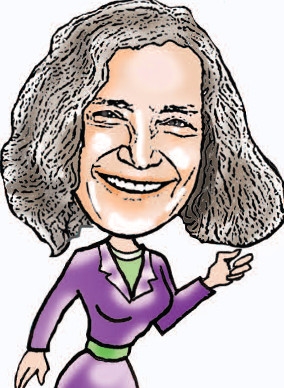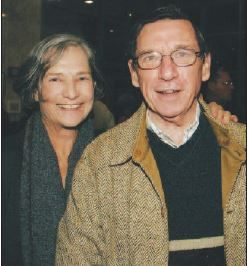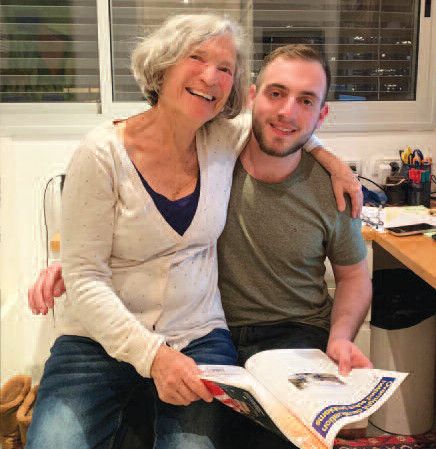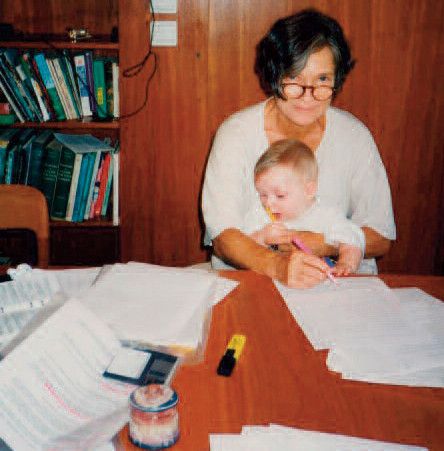40 Years an Editor
Have you ever been landed with something to do, totally unexpectedly?
I have this tendency, to do, to jump into things without thinking about it too much. Gert, my late husband, used to say to me: "How can you just do it, without analyzing, planning?"
Perhaps it is because I am a Sagittarius. So for the first time in my 81 years, today I googled Sagittarius to learn what are the characteristics of people born under this Zodiac sign: "Sagittarius energy inspires us to dream big, chase the impossible and take fearless risks." And what Sagittarians hate is prejudice, routines, rules, being bored, the word 'can't'. And they are adventurers and have a spirit of inquiry. Gert always used to say I was a 'good editor' because I know nothing and everything intrigued me. He, and Liz Trakeniski, my right-hand administrator for many years, were my sources of information.
That's what I did – I jumped into producing and editing a magazine. A mere comment from a woman in the audience at the meeting of 250 English Speakers in Herzliya, April 5th, 1979, that we "need a newsletter" set me going. So Sandra Heydecker and I produced the first ESRA Newsletter No. 1 within six weeks. I had never before edited anything, nor was I a writer. And Sandra deserted me in the middle of producing Newsletter No. 2.
From the outset the ESRA Newsletter was a forerunner. We were the first English speaking organization in Israel to solicit adverts. Our first treasurer, Morris Bacher, a true money man, said we didn't have the means to produce a newsletter, and being a man of deeds, he went out and solicited a few adverts. The other English speaking organizations at the time were heavily funded by the Jewish Agency. Conclusion: it's good not to have money, it makes one resourceful. Morris' ad efforts were followed a couple of years later by energetic volunteer Pat Zuckerman and when she wore out, our secretaries were drawn into the act, no easy task.
This first Newsletter, home-typed, hand-folded by volunteers, needed to be delivered to the list of English speakers we had compiled at that meeting on April 5th. Two brilliant and energetic young volunteers, Beverly Polatinsky and Averil Shulman, came up with the no-money solution – hand-delivery to the homes. So began this incredible hand-delivery of ESRAmagazine, still in practice today with our team of 315 volunteer postpersons.
The magazine's original 12 pages lasted 4 issues. Then began the gradual growth from 12 to 16 to 18, to 20, to 24, to 28, to 32, to 40, to 44, 48, 50, 64, 66, 72, 80 and in September 1991 we reached 88 pages which we maintained for 11 years. Then we jumped daringly to 108 pages, which we have maintained with great self-control till today.
The bubble burst when Micky Schneider entered the world of ESRAmagazine as its administrator. He was an absolute whiz at soliciting adverts, a 'combina' expert, effective and ingenious. He would find a way of convincing potential advertisers to advertise, offering them perks, free classifieds, trial periods, or longer periods or larger adverts for less money, or, or… Our advertising revenue grew, and with it so did the size of the magazine, from 15.5 x 21.0 cm to 15.5 x 27.0 cm, in March 1995.
Full color covers on every issue. Beautiful. Nikki Jason, our designer, was a young, brilliant, adventurous entrepreneur, who had studied design at a Wizo school, and it was she who nurtured us as we ventured into the larger format and color covers.
The larger format was a dream to produce and edit, but a nightmare in many ways. It caused innumerable problems with our magazine deliverers and even with our readers. The year that followed was one of the most difficult and painful years I have been through in ESRA. There were criticisms from some readers, pangs of longing for the little magazine "they could put in their handbag", or "read in the toilet", or "take with me on the bus". Some volunteer distributors refused to continue to deliver magazines because the load was too heavy for them, or because they were angry at the change. Frankie Cronin who coordinated the distribution was wonderfully supportive. She accepted the dropouts and looked for new distributors.
There were other hazards with the distribution of the larger format magazine. It didn't fit into the letter boxes of old buildings, and still doesn't, and had to be carefully folded. Shopping trolleys entered the delivery life of ESRAmagazines because the bundles were too heavy to carry.
I did suffer, and self-question. But I stood firm as I believed that this was the image ESRA should be projecting in the 1990's, a forward, with-it, dynamic, attractive organization which functions on a professional level, able to stand on its own in a high-tech changing world.
In our early days there was no modern technology, just cut and paste from the typed pages. Really painstaking and meticulous work the graphic designers had. They had to accompany me to the printers to make the corrections. Errors were a nightmare, almost. As technology advanced and eased the printing world, there was no need to sit on top of the graphic designers – everything could be handled by remote control, through our computers. Amazing advances.
The discovery of Dropbox, taught me by Daniel Silverton, one of our younger designers, changed our lives. Our current designer, Anthony Green, is incredible at storing our past articles and photos – anything I can't find, he can, a real magician. And he's clued up on world news, personages, events, in all fields – past and present –which adds vision and history to so many of our articles. I am just the opposite, truly, an utter ignoramus. Anthony also writes the clever and witty headlines which hopefully make readers smile. He also comes up with great feature ideas – like these special pages to celebrate our 200th issue.
Addi Cohen Ziv was one of our outstanding designers who for six years enhanced the magazine with creativity and intelligence. A baby interrupted our relationship.
The input of our magazine designers is so much more than just design. Every graphic designer who has ever worked on ESRAmagazine has enriched my editing knowledge and skills. They have been so much more than just designers, giving ideas, tips, improvements, help, and generously sharing with me what they know and think. Each has an individual personality, style and beliefs. Some are like writers who love their creations and believe there is no need for change, not even a word. Others are more flexible.
There was a time when our magazine covers enthused our readers. Especially the covers with paintings or historic photographs. Some readers used to cut out the covers and frame them, adorning their walls. Of course, here and there, readers bemoaned a cover, criticizing me for publishing it, as it made them depressed.
Our editorial board is terrific, invaluable. Their help and support are endless. You can read about each one of the members on pages ….. They vet all the articles, plan the forthcoming issues, critique the past one, and give good insightful feedback, positive and negative. At a morning meeting a couple of years ago, after a weighty discussion on what was happening in our country and our leaders, one of our members who is always witty, said she needed a vodka. No, I won't reveal her name. And down she went to the grocery shop and bought a bottle of vodka, which we stored for her and brought out at each meeting.
Mike Porter, another board member, in his 80's, is totally committed to the magazine, believes it is a gem. He comes to the office by bus, with carton boxes, fills them with old magazines and distributes them by hand in places where people sit and wait and have time to read, like launderettes, hairdressers, medical clinics.
Lucille Cohen recalls walking into her first editorial board meeting and being greeted by two members sitting round the table and they asked her about herself. As she opened her mouth to respond, she writes, "an energetic woman with presence swept into the room and called out, 'Quiet everyone. Let's get to work reading.' That no-nonsense editor was Merle, and I quickly realized that ESRAmagazine was a project of high, professional standards".
I remember the days when I objected strongly to having a "food column" – what, in ESRAmagazine? Today, worldwide, food is one of the hottest subjects and everyone wants recipes, recommendations on eating place, stories about food and wine. Our graphic designer of adverts, Nitzan Krivine, won the first TV Bake Off contest, together with Shy Golan, and they adorned the cover of mag no. 186.
Our proofreading process was an absolute saga. We were over-conscientious, with each article being proofed by three proofreaders. Those were the days when it was hand-proofed, on hard-copy pages. Each article had to be schlepped to proofreader after proofreader, and of course they lived in different towns – a feat of logistics. One of our avid and excellent proofreaders, Inge David, bewailed the fact that we finally digitalized our proofreading, tracking mistakes online. She mourned losing 'her job' which she loved, but she just couldn't handle the new techniques. But oh, the computerization did speed up and ease our proofreading.
The key of our office in the Herzliya Volunteer House was taken away from a young, beautiful but scatter-brained administrator we had, because she burned out the toaster oven which could have set the place alight, and she always forgot to turn off the building lights, and more. So no key to ensure that she could only come to the office when municipal workers were there.
We have made some real blunders, unfortunate and unforgiveable, like the time we printed that someone had died, and he was still alive and kicking.
I've been brought to tears by ESRA finance guys. Some years ago a new chair of finance came into power. He decided to show his muscles, that he was boss. He called me into a meeting. I was terrified and took my administrator with to hold my hand. Without discussion, he started demanding that I cut down the number of issues a year, reduce the number of pages, and so on. Money was the issue. Shattered, reduced to a nothing, I left the meeting, sat down in the basement, and wept.
Apropos finance, Josie Shlain, who at one stage was in charge of the magazine's finance and was a great protagonist of the magazine, understanding its value to ESRA, labored hard, unsuccessfully, to convince the finance committee that the magazine should be credited with some of the income from memberships and donations – that neither would be earning if it weren't for the magazine.
Gert and my daughters used to complain bitterly about the strong smell of magazines off the printing press which for a week or more were stored in our lounge in our home. Thousands and thousands of them took over our lounge until all the area distributors had collected them.
David, who used to deliver the magazines from the printers, told me recently how he recalled delivering five thousand hard-covered Table Manna cookbooks to my lounge, how they invaded our entire lounge up to the ceiling. It took me many long weeks to find storage places, of course free, and mostly in private homes – hooray for ESRA volunteers.
There have been some wonderful administrators of the magazine – Judy Fisher, Cheryl Liebson, Sue Joffe, Micky Schneider who took the magazine to new heights. There were those whose time with us was brief, but unforgettable because of the critical role they played in their short time. Rhonda Abramson converted a room in her apartment into the magazine office when we had to move out of Volunteer House for some eight months whilst it was being renovated. Our office volunteers worked there several times a week. Erica Raia Myria, a stunning looking woman from Greece, worked as a temp for six months whilst Naomi Gal was off having another baby. Erica understood website creation and thanks to her our magazine website was redesigned and digitally brought up-to-date.
Another gem was Caryn Ginsberg. Also a beautiful young woman, intelligent and totally committed to her job as magazine administrator. No money, no apartment, no car, no partner – Caryn used to schlep to work with two buses, stay long hours in order to 'catch' advertisers in the late afternoon when they might be able to spare a moment to talk to her. She was excellent at getting adverts, and kept up Micky's record. She used to send me walking around Tel Aviv to deliver magazines to potential advertisers. Her determined efforts paid off. Unfortunately, she left Israel.
Four hundred and twenty-two (422) volunteers are involved in the production and distribution of each ESRAmagazine. The editorial board, column editors, writers, proofreaders, webmaster, volunteers in the administration and website work, illustrators, translators, photographers, and the incredible volunteer administrator, Neville Friedland without whom I could not manage. And then of course the designers, Hauser the printer who for 29 years has never let us down.
So, as you see, ESRAmagazine is a product of many minds and many hands. Thank you to you all for helping me to stay on track for forty years. And to you our readers and advertisers. I love you all.











Comments